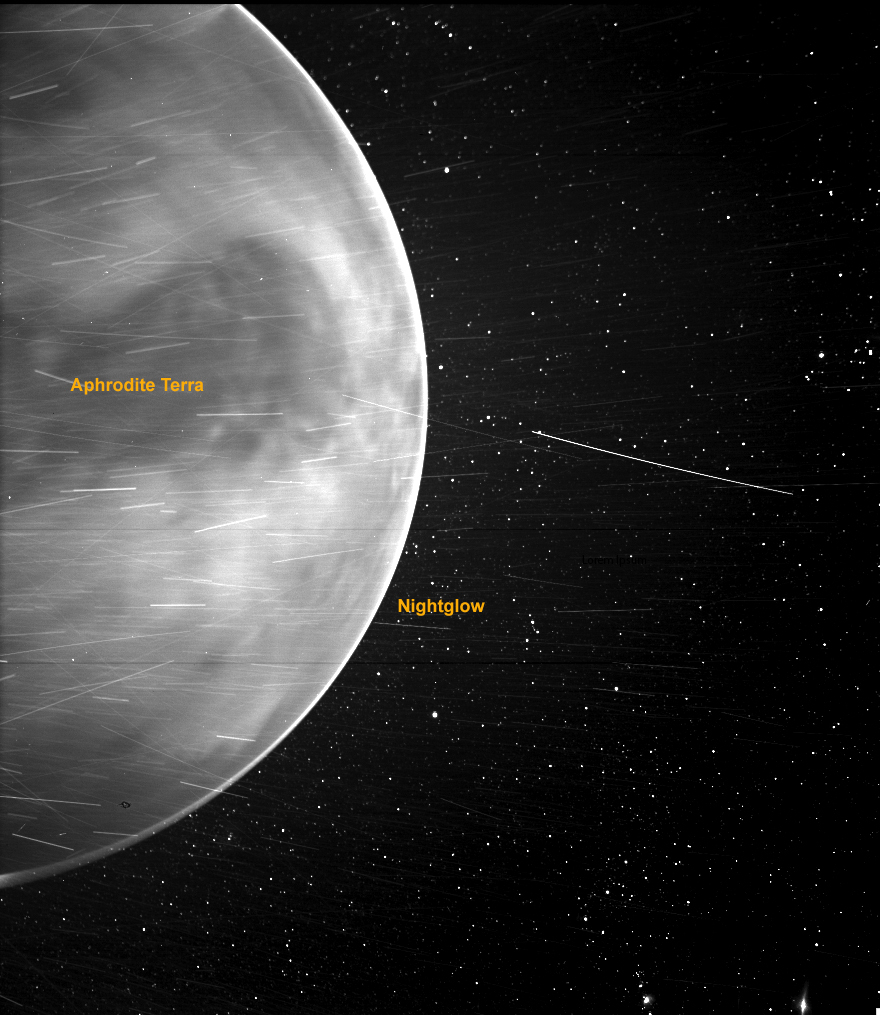Nightside observations by the Parker Solar Probe: implications for the reality of the Ashen Light
2022 August 7
The Parker Solar Probe is a NASA mission designed to investigate the Sun’s outer corona. Launched in 2018, it will be the first spacecraft to fly into the corona. In 2020 July, it flew past Venus and captured images of the surface in visible wavelengths. The probe performed another flyby on 2022 Feb 20 and all of these observations have allowed a video to be constructed (a still from this is shown).1

The most remarkable aspect of the Parker probe’s results is that the night side of Venus was seen in visual wavelengths. The surface of Venus is incredibly hot, at around ~460°C, and as a result the rocks glow due to the heat. Normally the surface is hidden by the clouds, but Parker used its wide-field imager – the WISPR – to image the night side in infrared (IR) and visual wavelengths close to the IR end of the spectrum. A remarkable amount of surface detail is visible through the cloud tops, including plains and plateaux.
This is the first time observations of the surface have been made in visible wavelengths. Also observed was a thin luminous halo, which is caused by ionised oxygen in the atmosphere. These results have been published in the Geophysical Research Letters journal.2 It is nice to see that the paper references an elongation report by McKim which gives a good description of amateur attempts to capture infrared thermal emission.3
Naturally this recent discovery has prompted speculation amongst both professional scientists and amateur astronomers about the reality of the Ashen Light. For those of you unfamiliar with the phenomenon, the Ashen Light is the reported visual glow of the night side of the disc when the planet is in the crescent stage. The phenomenon was first reported in 1643, and although a number of reliable observers have reported it over the decades, there has yet to be a firm confirmation of the effect. If the glowing surface can sometimes be seen (perhaps caused by thinning clouds over the night side, or active volcanoes making portions of the surface hotter), then this may be the explanation behind this elusive phenomenon.
I must confess that I have never seen the Ashen Light in all the years that I have been observing the planet – but I am more sensitive to the blue end of the spectrum, and if the glowing surface is the explanation then one would require sensitivity at the red end. I had many conversations with the late Sir Patrick Moore about the Ashen Light, as he was absolutely certain the phenomenon was real. Much more work needs to be done of course, but perhaps we might now finally have some sort of explanation!
Paul Abel, Director, Mercury & Venus Section
1 NASA Parker Solar Probe website
2 Wood B. E. et al., ‘Parker Solar Probe imaging of the night side of Venus’, Geophysical Letters, 49, issue 3 (2022 Feb 16)
3 McKim R. J., ‘The eastern and western elongations of Venus, 2007–2017 II: The nocturnal hemisphere’, J. Br. Astron. Assoc., 129(3) (2019)
| The British Astronomical Association supports amateur astronomers around the UK and the rest of the world. Find out more about the BAA or join us. |
